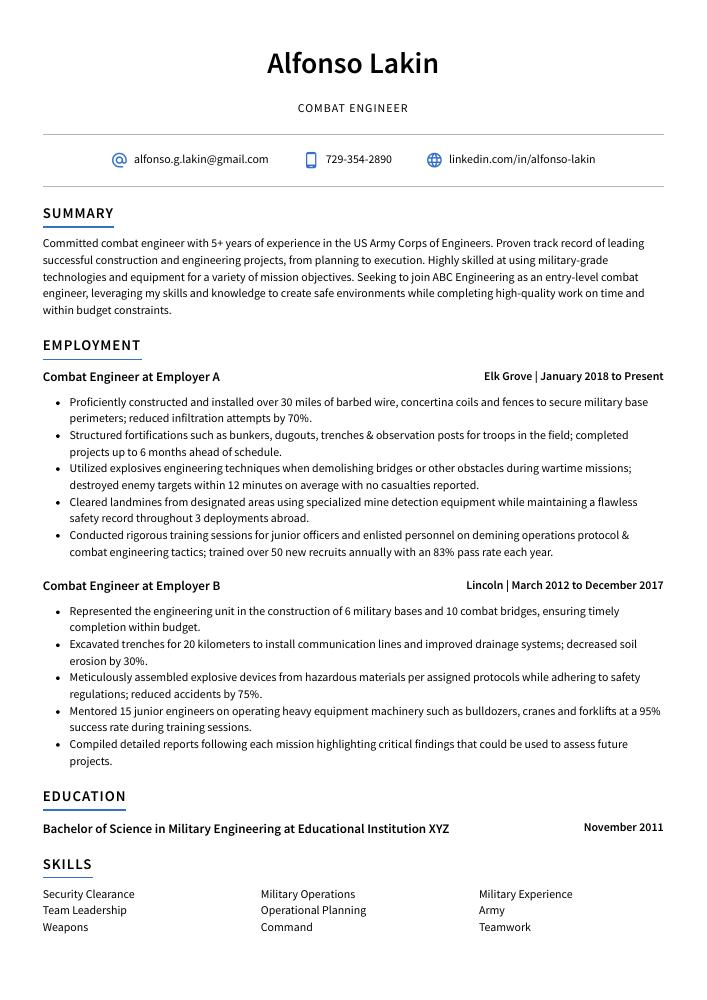Combat Engineer Resume Guide
Combat engineers are responsible for a wide range of activities, from building and maintaining roads and bridges to constructing defensive positions. They use engineering principles to plan, design, construct, maintain or repair combat support systems such as fortifications and obstacles in order to ensure the success of military operations. In addition they provide technical advice on tactical movements during offensive or defensive operations.
You have the experience and training to be a successful combat engineer, but potential employers don’t know that. To help them understand your qualifications and make you stand out from other applicants, you must write an impressive resume.
This guide will walk you through the entire process of creating a top-notch resume. We first show you a complete example and then break down what each resume section should look like.
Table of Contents
The guide is divided into sections for your convenience. You can read it from beginning to end or use the table of contents below to jump to a specific part.
Combat Engineer Resume Sample
Alfonso Lakin
Combat Engineer
[email protected]
729-354-2890
linkedin.com/in/alfonso-lakin
Summary
Committed combat engineer with 5+ years of experience in the US Army Corps of Engineers. Proven track record of leading successful construction and engineering projects, from planning to execution. Highly skilled at using military-grade technologies and equipment for a variety of mission objectives. Seeking to join ABC Engineering as an entry-level combat engineer, leveraging my skills and knowledge to create safe environments while completing high-quality work on time and within budget constraints.
Experience
Combat Engineer, Employer A
Elk Grove, Jan 2018 – Present
- Proficiently constructed and installed over 30 miles of barbed wire, concertina coils and fences to secure military base perimeters; reduced infiltration attempts by 70%.
- Structured fortifications such as bunkers, dugouts, trenches & observation posts for troops in the field; completed projects up to 6 months ahead of schedule.
- Utilized explosives engineering techniques when demolishing bridges or other obstacles during wartime missions; destroyed enemy targets within 12 minutes on average with no casualties reported.
- Cleared landmines from designated areas using specialized mine detection equipment while maintaining a flawless safety record throughout 3 deployments abroad.
- Conducted rigorous training sessions for junior officers and enlisted personnel on demining operations protocol & combat engineering tactics; trained over 50 new recruits annually with an 83% pass rate each year.
Combat Engineer, Employer B
Lincoln, Mar 2012 – Dec 2017
- Represented the engineering unit in the construction of 6 military bases and 10 combat bridges, ensuring timely completion within budget.
- Excavated trenches for 20 kilometers to install communication lines and improved drainage systems; decreased soil erosion by 30%.
- Meticulously assembled explosive devices from hazardous materials per assigned protocols while adhering to safety regulations; reduced accidents by 75%.
- Mentored 15 junior engineers on operating heavy equipment machinery such as bulldozers, cranes and forklifts at a 95% success rate during training sessions.
- Compiled detailed reports following each mission highlighting critical findings that could be used to assess future projects.
Skills
- Security Clearance
- Military Operations
- Military Experience
- Team Leadership
- Operational Planning
- Army
- Weapons
- Command
- Teamwork
Education
Bachelor of Science in Military Engineering
Educational Institution XYZ
Nov 2011
Certifications
Combat Engineer (12B)
United States Army
May 2017
1. Summary / Objective
The summary/objective at the top of your resume should be a brief but powerful statement that showcases why you are an ideal candidate for the combat engineer position. Here is where you can highlight your military experience, any certifications or training courses related to engineering and construction, as well as any special skills such as problem solving and communication. You could also mention how many years of experience in this field you have and what sets you apart from other candidates.
Below are some resume summary examples:
Hard-working, detail-oriented Combat Engineer with 5+ years of experience in the US Army. Seeking a position that will utilize my technical knowledge and problem-solving skills to make an impact on military operations. At XYZ, led successful missions involving demolition, construction/repair of fortifications and obstacles, reconnaissance support for combat units as well as landmine clearance operations. Received multiple medals for service excellence and dedication during active duty deployments.
Detail-oriented combat engineer with 6+ years of experience in the US Army. Experienced in operating and maintaining heavy equipment, managing personnel, coordinating engineering operations, and planning combat missions. Skilled at assessing terrain to develop effective defense strategies and ensure efficient use of resources during deployments. Recognized for my ability to build bridges quickly under extreme pressure while working with minimal civilian support or resources.
Professional combat engineer with 8+ years of experience in the military. Seeking to leverage expertise and skills in tactical operations, combat engineering tasks, mine warfare, and demolition for ABC Company. At XYZ Military Base, led a team of 12 personnel through an extensive landmine clearance project on schedule and under budget. Awarded the “Outstanding Achievement” medal for successful completion of mission objectives without any casualties or injuries.
Skilled combat engineer with extensive experience in infantry support, tactical operations, and combat construction. Proven ability to motivate a team of up to 50 personnel during intensive training exercises and deployment overseas. Recognized for working effectively under pressure while ensuring the safety of others as well as equipment and supplies. Looking to join ABC Corps where my expertise can be leveraged for successful deployments abroad.
Determined combat engineer with 4+ years of service in the US Marine Corps. Seeking to build upon existing experience and knowledge by providing engineering support for ABC. Proven record of successfully leading and managing combat missions involving reconnaissance, demolition, construction, and repair projects under extreme conditions. Received numerous awards such as Navy Achievement Medal for outstanding performance during deployments.
Accomplished combat engineer with 7+ years of experience in the military and 5+ years as a civilian contractor. Proven track record leading teams to complete complex construction projects, including bridges, roads, fortifications, and tactical installations. Eager to apply expertise at ABC Engineering Solutions where I can help build safe structures while meeting tight deadlines.
Energetic combat engineer with 8+ years of experience in the armed forces. Served as a team leader and supervisor during multiple deployments, overseeing daily operations; received commendations for exemplary service. Now looking to leverage organizational and technical skills at ABC Defense Corp., where I can use my knowledge and expertise to help build better defense systems.
Talented combat engineer with 4+ years of experience in tactical operations, construction engineering, and force protection. Seeking to leverage expertise in combat tactics and weapons systems to become the next Combat Engineer for ABC Company. At XYZ Infantry Unit, developed a comprehensive training program that improved accuracy by 44% among junior officers.
2. Experience / Employment
The employment (or experience) section is where you provide details on your past jobs. This should be written in reverse chronological order, meaning the most recent job is listed first.
When writing this section, stick to bullet points; doing so makes it easier for a reader to quickly take in what you have said. You want to think about the specific tasks and results of each role when crafting your bullets – try not to just list duties but also explain how they were accomplished or the outcomes achieved from them.
For example, instead of saying “Built defensive structures,” you could say, “Constructed fortified walls using sandbags and barbed wire that provided protection against enemy forces.”
To write effective bullet points, begin with a strong verb or adverb. Industry specific verbs to use are:
- Constructed
- Operated
- Inspected
- Assessed
- Dismantled
- Cleared
- Excavated
- Installed
- Monitored
- Fabricated
- Repaired
- Upgraded
- Tested
- Troubleshot
- Secured
Other general verbs you can use are:
- Achieved
- Advised
- Compiled
- Coordinated
- Demonstrated
- Developed
- Expedited
- Facilitated
- Formulated
- Improved
- Introduced
- Mentored
- Optimized
- Participated
- Prepared
- Presented
- Reduced
- Reorganized
- Represented
- Revised
- Spearheaded
- Streamlined
- Structured
- Utilized
Below are some example bullet points:
- Successfully designed and developed fortification structures for combat areas, reducing the risk of hostile attacks by 35%.
- Revised safety protocols and procedures in line with military standards; reduced workplace accidents by 20% within 6 months.
- Introduced a new range of explosive strategies used to breach enemy barricades, resulting in an increase of successful mission completions by 45%.
- Achieved certification as an Expert Combat Engineer after passing all required examinations with top marks in less than 3 months.
- Spearheaded the construction of 8 bridges across different battlefields over the course of 4 weeks; completed projects on time and under budget without compromising quality or safety standards.
- Troubleshot and repaired military vehicles and equipment, including bulldozers, tanks and other combat engineering machinery; reduced downtime by 35% in the last quarter.
- Monitored battlefield conditions to identify strategic locations for bridges, roadways, fortifications or any other type of construction project necessary; identified 3 suitable areas over 200 sq. Miles that resulted in successful completion of missions within budget limits.
- Independently conducted safety inspections on all assigned tools, weapons systems and machines prior to use in order to ensure operational readiness at all times; completed over 100+ checks with a 0% failure rate during deployment period.
- Assessed potential threats from enemy forces when creating structures or setting up defenses such as trip wires or anti-personnel mines; successfully defended against 8 hostile incursions without any casualties due to superior threat analysis skillset & experience level possessed by team members under supervision/guidance provided by self.
- Tested new technologies developed for infantry warfare purposes such as remote operated robotic arms used for clearing minefields safely – success rate exceeded 85%.
- Formulated and implemented innovative engineering plans for construction of defensive fortifications, bridges and roads; reduced build time by an average of 30% over the span of 5 months.
- Prepared minefields and anti-tank obstacles to secure tactical positions in forward operating bases across multiple countries; successfully neutralized 7 hostile threats with minimal casualties.
- Streamlined operations within field offices by developing efficient organizational systems that allowed for easier management of personnel, materials and equipment during deployments abroad.
- Actively monitored battlefields for potential safety hazards such as landmines or unexploded ordinance while providing security clearance on foot patrol at all times; averted 4 disasters due to timely response in hazardous conditions.
- Secured perimeters using barbed wire entanglements, reinforced sandbags walls & trenches along with other military grade defense mechanisms without compromising structural integrity; increased overall durability rate by 20%.
- Repaired and maintained military equipment, vehicles and weapons systems in the field; expedited response time by 50% with quick troubleshooting procedures.
- Dismantled enemy fortifications such as minefields and obstacles to secure areas for further advance of friendly forces; reduced casualty rates among personnel by 25%.
- Expedited completion of bridge building projects under extreme weather conditions while working with a team of combat engineers to build over 15 bridges within 2 months.
- Reduced construction costs on multiple engineering projects through creative problem-solving skills, resulting in an overall cost savings of $12,000 per project on average.
- Substantially improved communication links between battlefront positions using innovative methods for installing radio antennas and satellite receivers up to 10 km away from base camp locations.
- Coordinated and supervised the construction of over 200 military fortifications, including bunkers and barricades; reduced project completion time by 15%.
- Presented technical briefings to senior officers on engineering projects, equipment and techniques; identified cost-saving measures that resulted in $3,000 savings annually.
- Reorganized operational strategies with other engineers in order to maximize effectiveness of resources and personnel during missions; successfully completed all assigned tasks without any casualties or injuries sustained.
- Advised troops on proper safety protocols for handling explosives as well as building protective structures quickly under challenging conditions; decreased potential hazards by 20%.
- Consistently demonstrated superior knowledge when troubleshooting machinery malfunctions while maintaining a high standard of accuracy throughout operations at all times.
- Installed and maintained defensive systems such as minefields, barriers and wire obstacles in hostile environments; reduced total setup time by 20% over 3 months.
- Demonstrated proficiency with a variety of engineering equipment including explosives, bulldozers and bridge-laying tanks to construct bridges and breach enemy fortifications.
- Participated in field exercises designed to test the effectiveness of installations against simulated attacks, successfully thwarting all attempts while training 6 new team members on basic engineering skillset operations along the way.
- Optimized existing routes for military supply convoys by clearing rubble from roadsides or creating bypasses around dangerous areas; improved overall convoy speed by 15%.
- Confidently operated heavy construction machinery when constructing airfields, bunkers or other structures necessary for battlefield support; completed projects ahead of schedule 5 out 10 times within an 8-month period.
- Efficiently operated and maintained construction equipment including bulldozers, cranes and other specialized heavy machinery to build defensive structures on the battlefield; improved overall operations speed by 15%.
- Inspected terrain conditions before constructing engineering works such as bunkers, trenches, bridges & roads while ensuring safety standards were met at all times.
- Developed plans for fortification projects in collaboration with senior officers; oversaw a team of 20 personnel in completing complex tasks within budget and ahead of schedule.
- Constructed minefields across 2km x 3km area using advanced explosive detection techniques to protect military base against enemy intrusion; minimized accidental explosions by 40%.
- Improved bridge infrastructure along supply routes through regular maintenance checks that identified weak points and vulnerabilities; increased lifespan of these bridges by 50% on average per year.
- Facilitated the construction of military infrastructure, including bridges and roads; successfully completed projects 2 weeks ahead of schedule on average.
- Fabricated anti-tank traps, fortifications and other defensive measures in order to protect troops from enemy attack; reduced the risk of casualties by 50%.
- Upgraded existing equipment with new technologies such as radio communications systems and surveillance cameras; improved operational efficiency by 20%.
- Thoroughly inspected all tools & vehicles used for engineering operations prior to every mission, ensuring that they were safe for use under extreme conditions; minimized repair costs by $5,000 annually.
3. Skills
Two organizations that have advertised for a position with the same title may be searching for individuals whose skills are quite different. For instance, one might be looking for someone who is knowledgeable in the use of explosives, while another may want a combat engineer with experience in construction and engineering.
Therefore, it is important to tailor your skills section according to each job you are applying for. This will ensure that applicant tracking systems can pick out the keywords they need to pass on your resume to human recruiters.
In addition, this section should not just list all of your relevant skills; instead, you should focus on those most pertinent to each position and elaborate further by discussing them in other sections such as the summary or work experience.
Below is a list of common skills & terms:
- Army
- Combat
- Command
- Communication
- Defense
- Demolition
- DoD
- Explosives
- First Aid
- Force Protection
- Government
- Military Experience
- Military Operations
- Military Training
- National Security
- Operational Planning
- Security
- Security Clearance
- Team Leadership
- Teamwork
- Time Management
- Weapons
4. Education
Adding an education section to your resume will depend on how far along you are in your career. If you just graduated and have no prior work experience, it is best to mention your education below the resume objective. However, if you have worked as a combat engineer for some time now and can showcase plenty of relevant skills and responsibilities, omitting an education section may be more beneficial.
If including an education section, try to list courses related to engineering or military science that could help demonstrate knowledge pertinent to the job role.
Bachelor of Science in Military Engineering
Educational Institution XYZ
Nov 2011
5. Certifications
Certifications are a great way to demonstrate your knowledge and expertise in a certain field. They show that you have taken the time to learn about the subject matter, as well as prove that you are proficient in it.
Including certifications on your resume can be beneficial when applying for jobs, especially if they relate directly to the position or industry. It is important to make sure all of your certifications are up-to-date and relevant so employers know you’re serious about staying current with industry trends.
Combat Engineer (12B)
United States Army
May 2017
6. Contact Info
Your name should be the first thing a reader sees when viewing your resume, so ensure its positioning is prominent. Your phone number should be written in the most commonly used format in your country/city/state, and your email address should be professional.
You can also choose to include a link to your LinkedIn profile, personal website, or other online platforms relevant to your industry.
Finally, name your resume file appropriately to help hiring managers; for Alfonso Lakin, this would be Alfonso-Lakin-resume.pdf or Alfonso-Lakin-resume.docx.
7. Cover Letter
Cover letters are an important part of the job application process. They are usually made up of 2 to 4 brief paragraphs and provide more detail than what is already mentioned in a resume. Cover letters allow applicants to demonstrate their suitability for a role, explain why they’re interested in it, and highlight any relevant qualifications or experience that would be beneficial for the position.
Whilst not all jobs require you to submit one, writing a cover letter can help your application stand out from others by displaying your personality as well as professional skillset. Therefore, submitting one with each job application could give you an edge over other candidates who don’t include them!
Below is an example cover letter:
Dear Vita,
I am writing to apply for the position of Combat Engineer with the United States Army. As a highly skilled and experienced engineer, I am confident I can be an asset to your organization.
My experience includes working as an engineer in both combat and non-combat situations. In my most recent role, I was responsible for leading a team of engineers in Iraq during Operation Iraqi Freedom. My duties included supervising the construction of roads, bridges, and other infrastructure projects while also providing support to troops in combat operations.
In addition to my engineering experience, I have also received training in demolition and explosives disposal. This training has come in handy on many occasions, including when I successfully disarmed an improvised explosive device (IED) that had been planted by insurgents near one of our construction sites.
I am confident that my skills and experience will enable me to make a positive contribution to your organization. I look forward to speaking with you about this opportunity soon.
Sincerely,
Alfonso
Combat Engineer Resume Templates
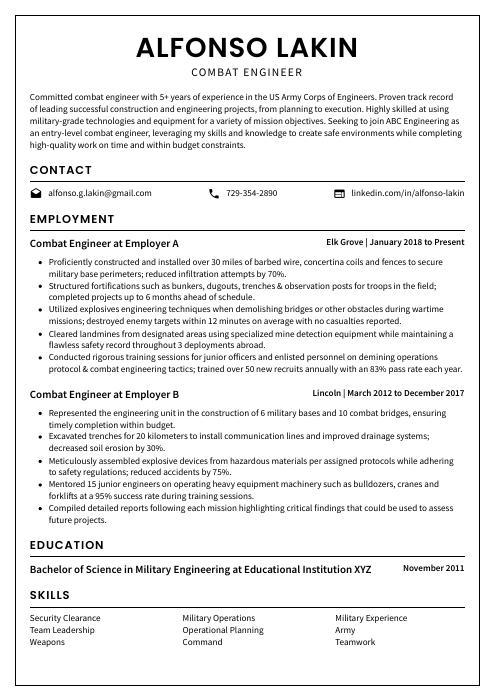 Cormorant
Cormorant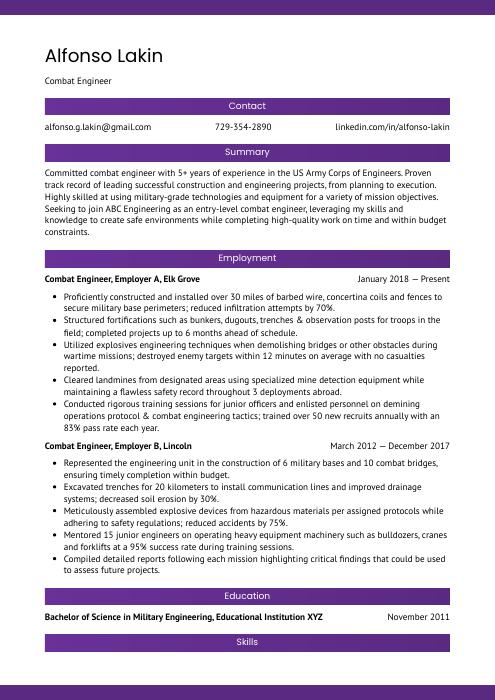 Jerboa
Jerboa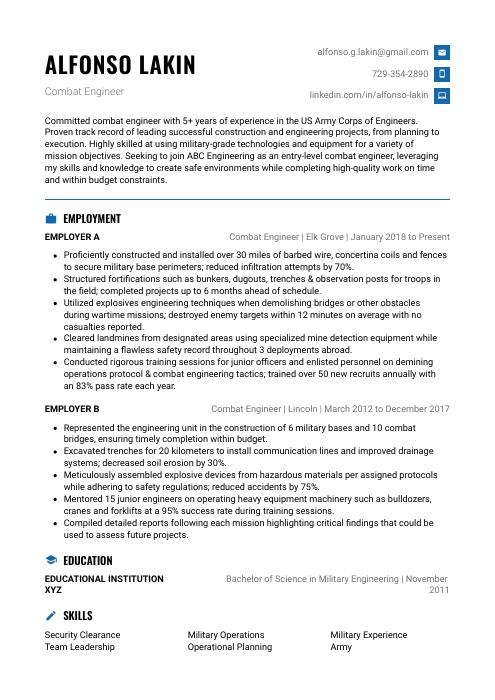 Echidna
Echidna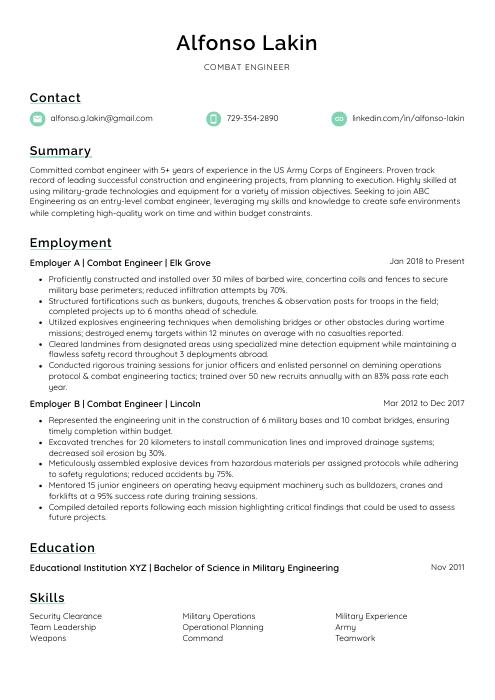 Lorikeet
Lorikeet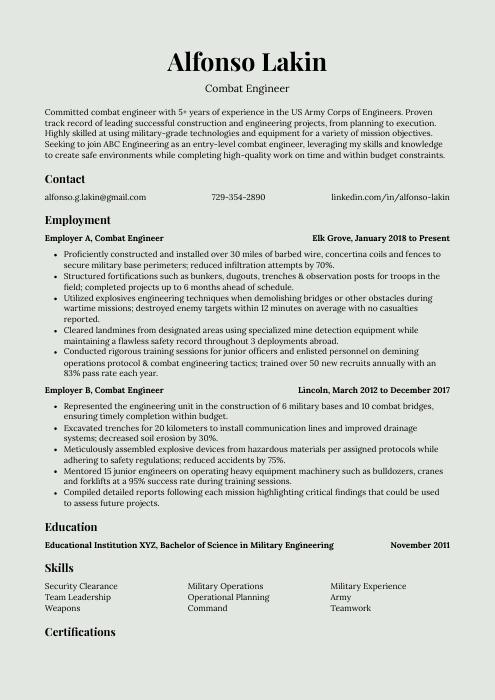 Saola
Saola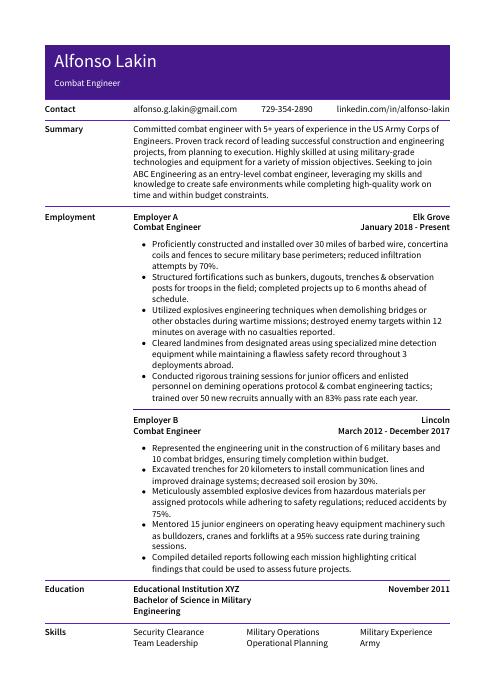 Pika
Pika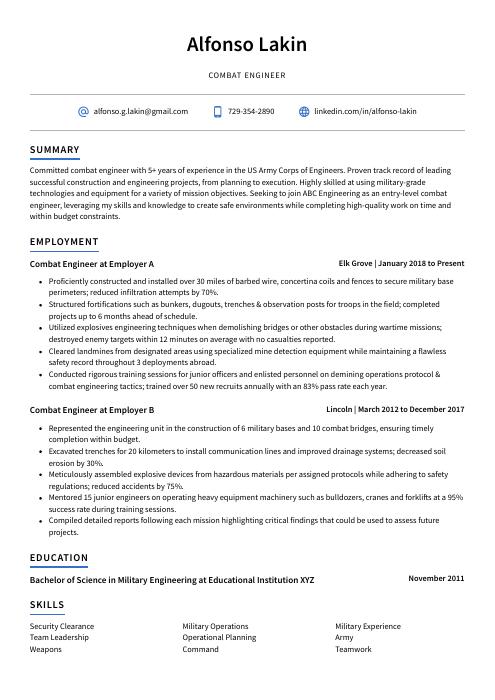 Axolotl
Axolotl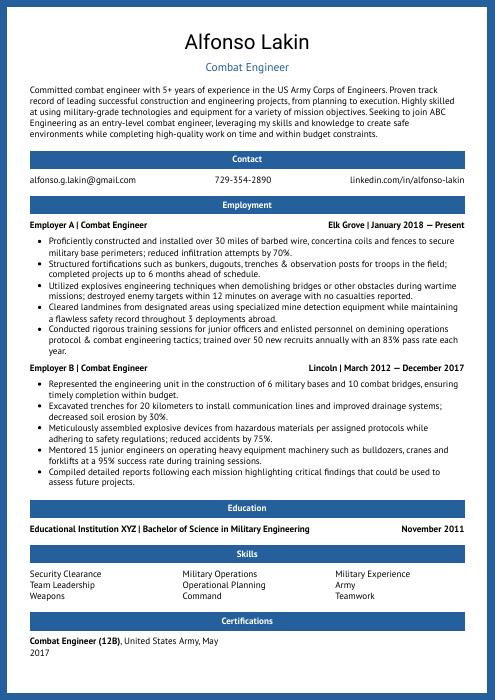 Ocelot
Ocelot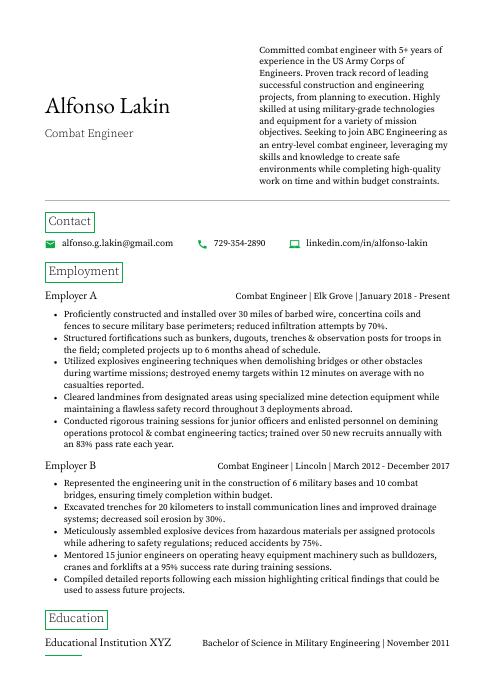 Quokka
Quokka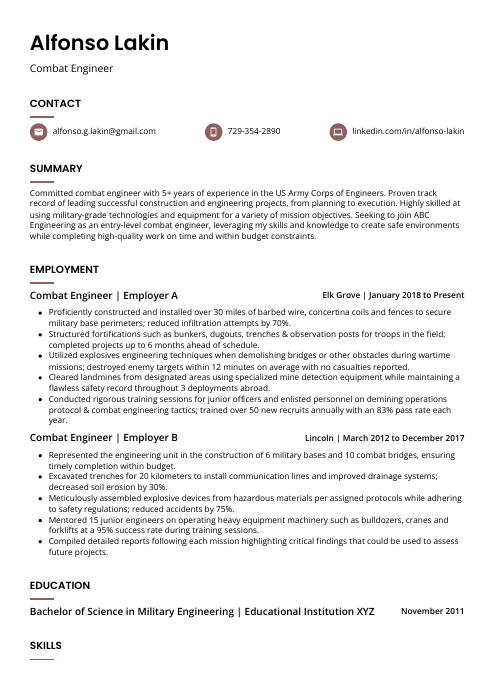 Fossa
Fossa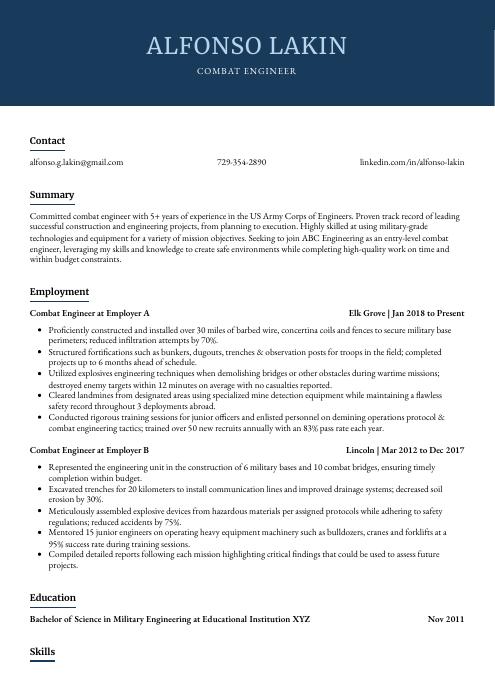 Bonobo
Bonobo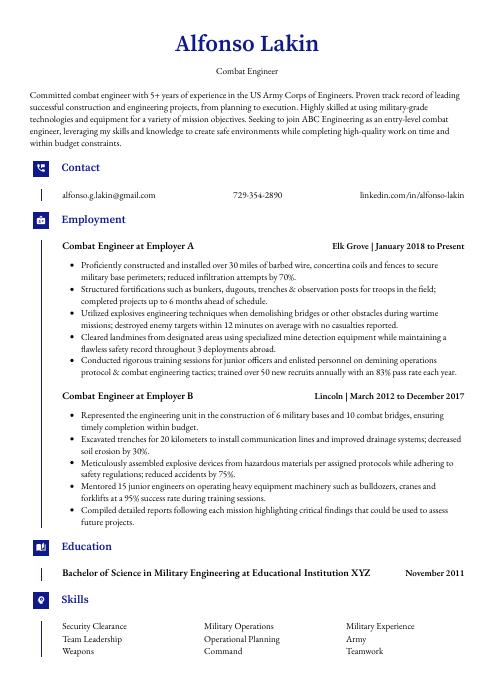 Gharial
Gharial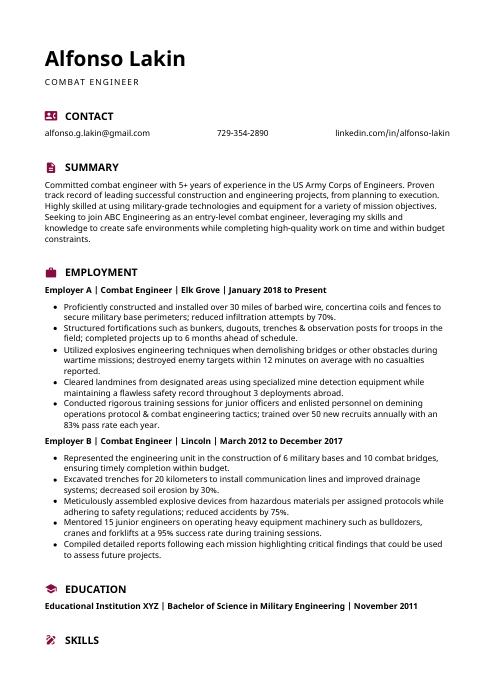 Hoopoe
Hoopoe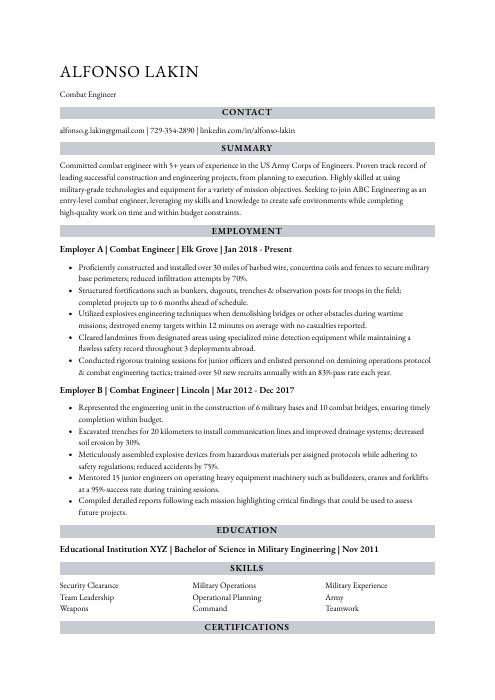 Numbat
Numbat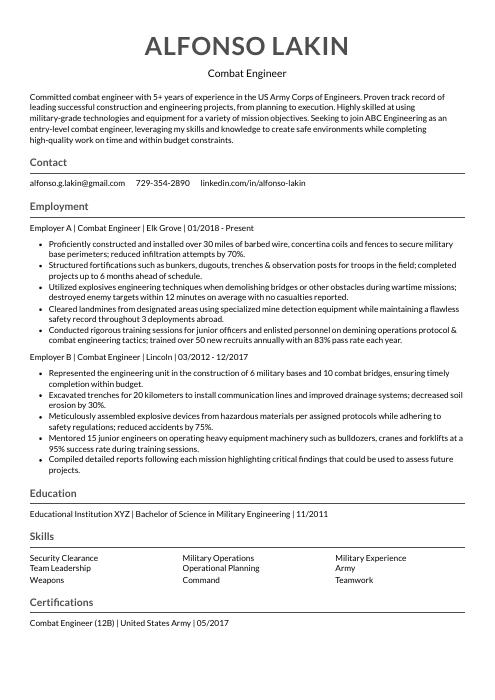 Indri
Indri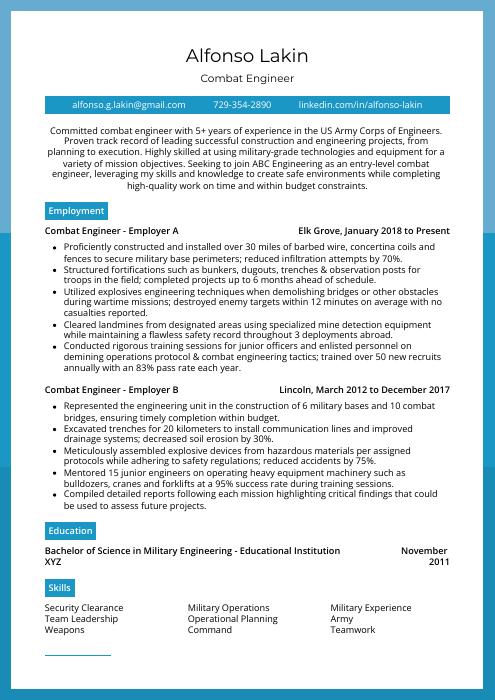 Rhea
Rhea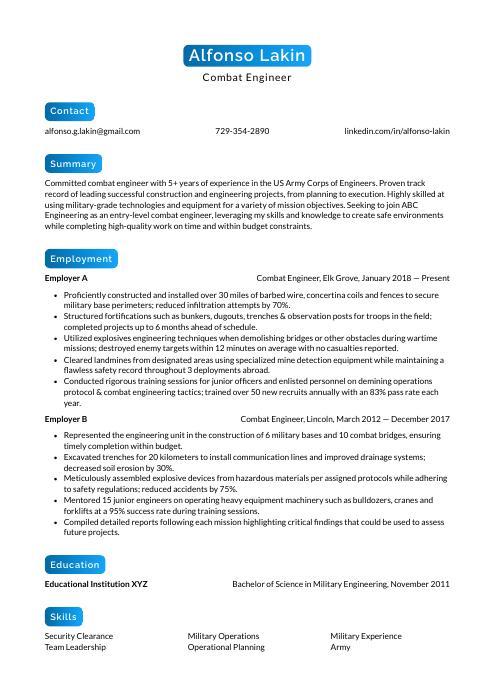 Kinkajou
Kinkajou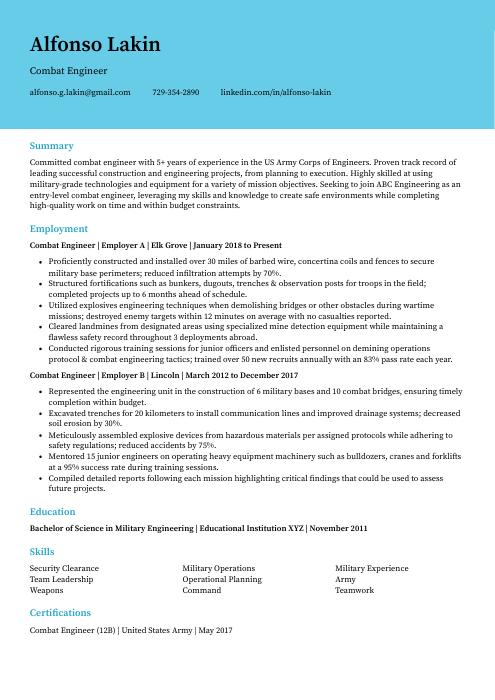 Dugong
Dugong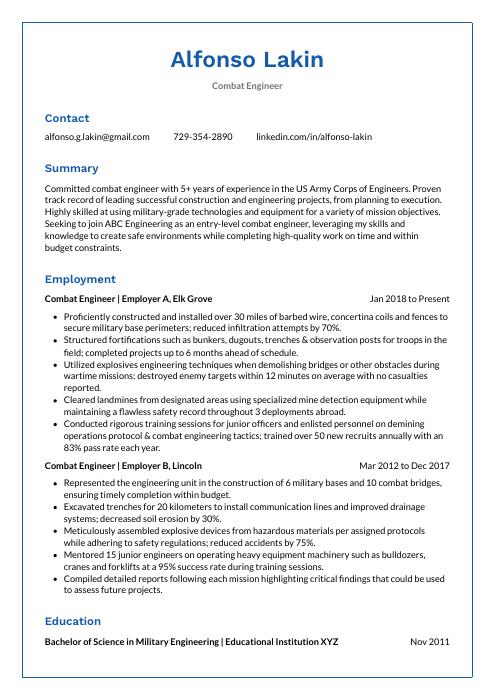 Markhor
Markhor Rezjumei
Rezjumei
